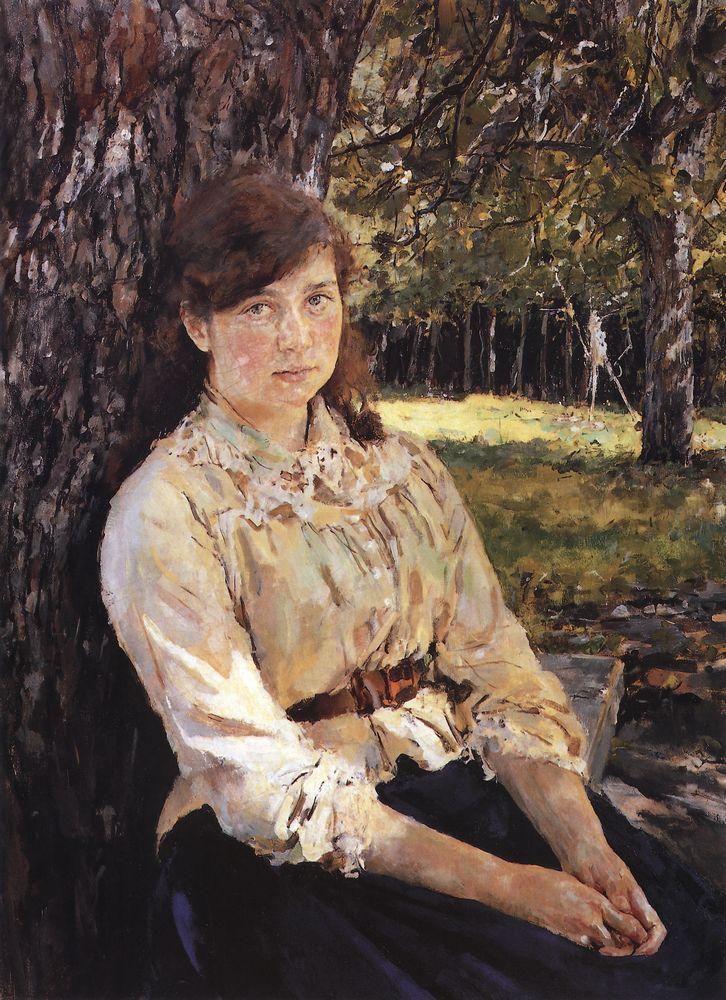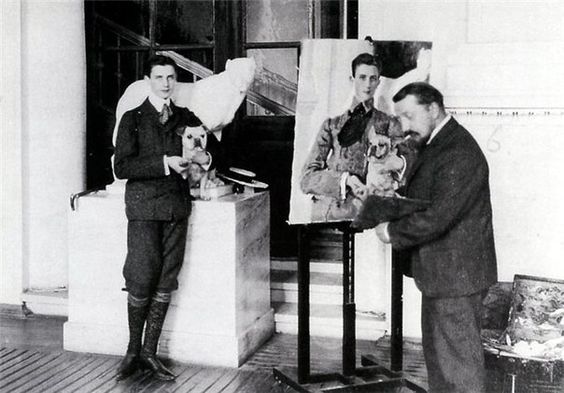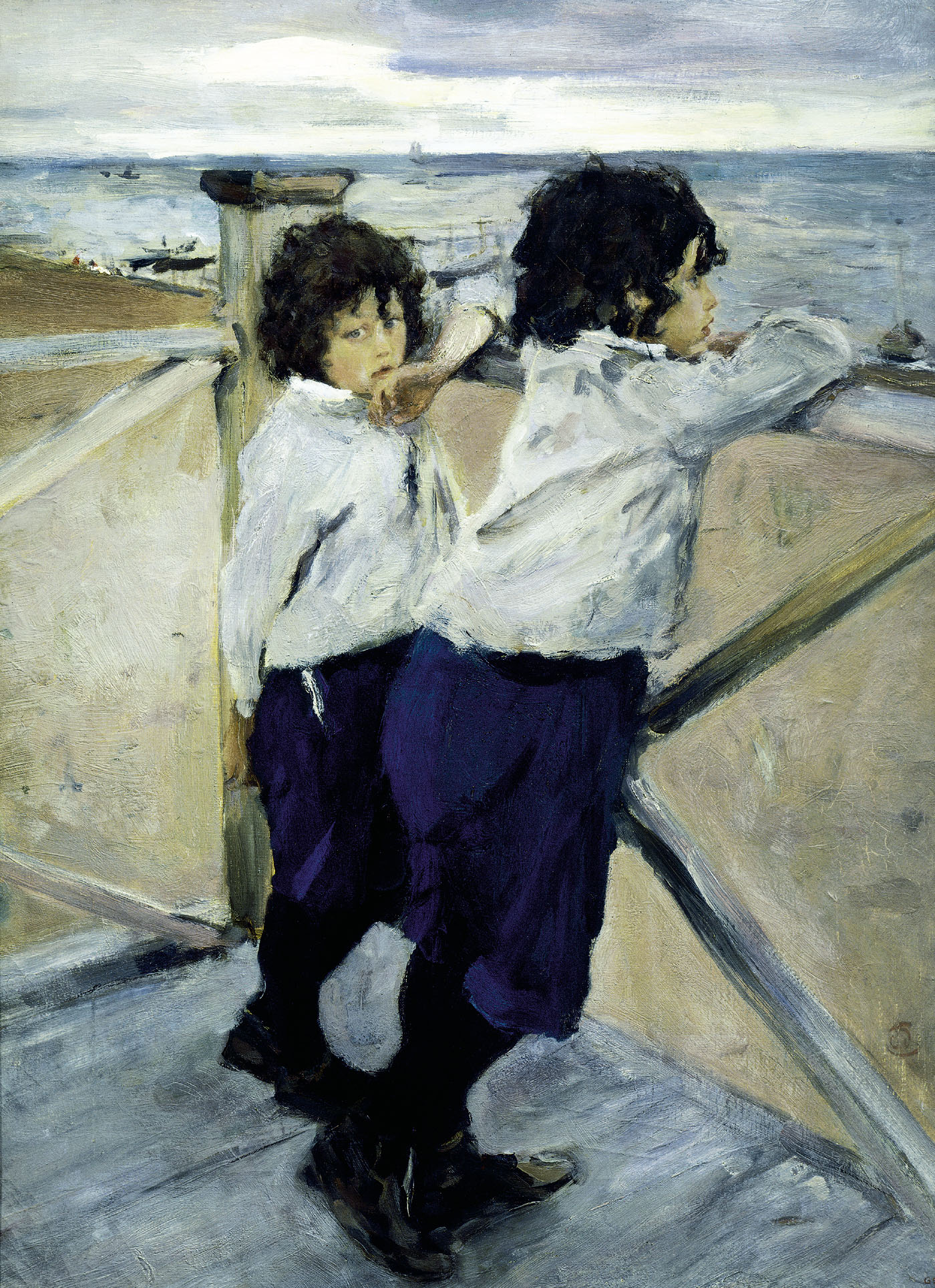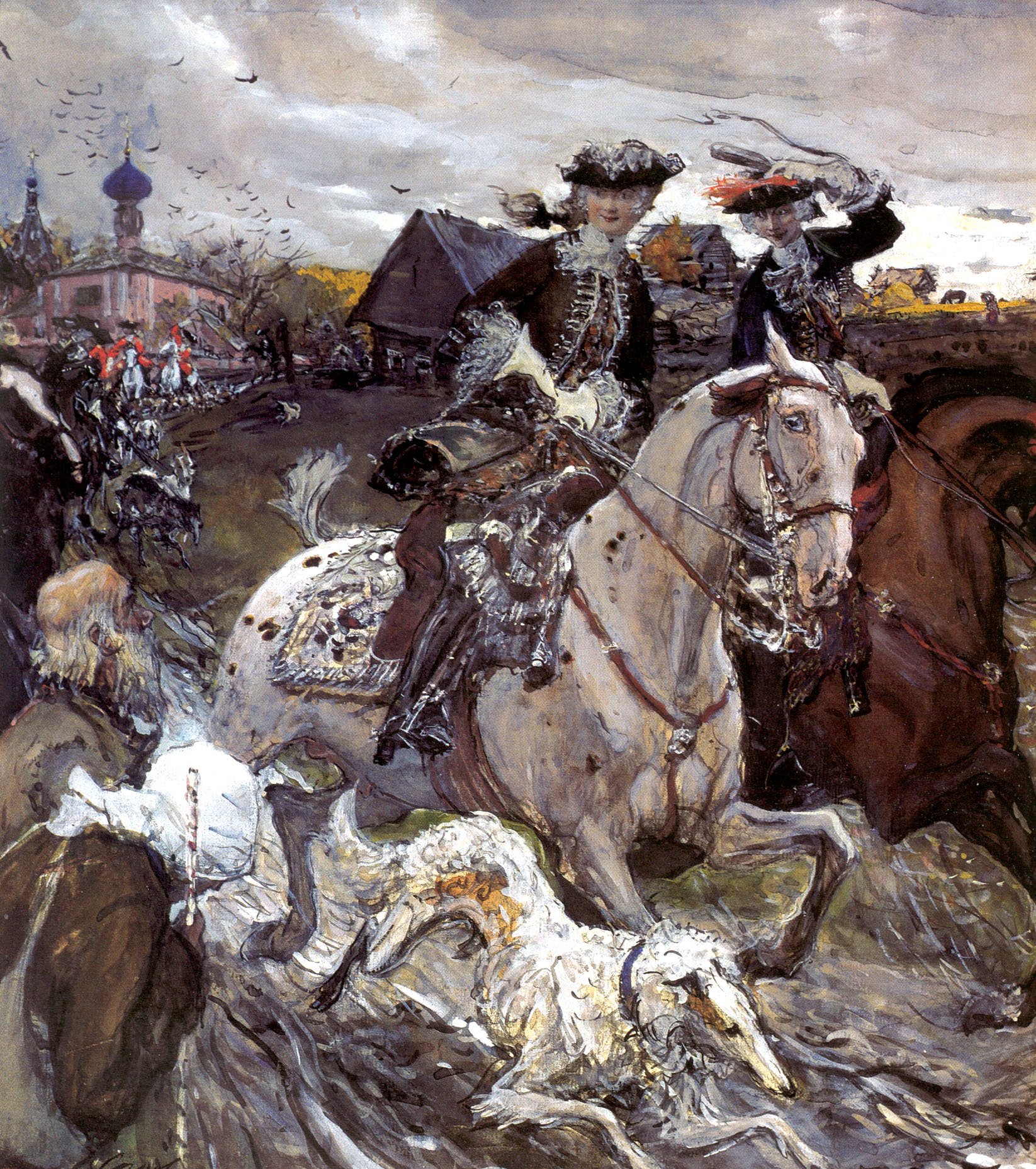Valentin Serov on:
[Wikipedia]
[Google]
[Amazon]
Valentin Alexandrovich Serov (russian: Валенти́н Алекса́ндрович Серо́в; 19 January 1865 – 5 December 1911) was a
 The greatest works of Serov's early period were portraits: '' The Girl with Peaches'' (1887), and ''The Girl Covered by the Sun'' (1888), both in the Tretyakov Gallery. In these
The greatest works of Serov's early period were portraits: '' The Girl with Peaches'' (1887), and ''The Girl Covered by the Sun'' (1888), both in the Tretyakov Gallery. In these
 Initially abstaining from the polychromatic, brightly colored painting style of the 1880s, Serov often preferred a dominant scale of black-grey or brown tones. Impressionistic features appeared sometimes in composite construction of a portrait, or to capture a sense of spontaneous movement. As in the work of his contemporaries
Initially abstaining from the polychromatic, brightly colored painting style of the 1880s, Serov often preferred a dominant scale of black-grey or brown tones. Impressionistic features appeared sometimes in composite construction of a portrait, or to capture a sense of spontaneous movement. As in the work of his contemporaries
 Serov married Olga Trubnikova in 1889. His wife and his children were the subject of many of his works. Notably, his painting ''Children'' was of his sons Yura and Sasha. His children were Olga, Alexander(Sacha), George (Yura), Michael and Anton.
Serov married Olga Trubnikova in 1889. His wife and his children were the subject of many of his works. Notably, his painting ''Children'' was of his sons Yura and Sasha. His children were Olga, Alexander(Sacha), George (Yura), Michael and Anton.
 During his late period, which began in 1900, Serov was a member of " The World of art", an influential Russian art association and magazine which grew, in part, out of dissatisfaction with the Itinerants movement. At the start of the 20th century, Serov was at a stylistic turning point: features of impressionism disappeared from his work, and his modernistic style developed, but the characteristic truthful and realistic comprehension of the nature of his subjects remained constant. In the early 20th century Serov created heroic portrait images; within the genre of the fashionable portrait, Serov focused on the dramatic depiction of creative artists, writers, actors, and musicians of import:
During his late period, which began in 1900, Serov was a member of " The World of art", an influential Russian art association and magazine which grew, in part, out of dissatisfaction with the Itinerants movement. At the start of the 20th century, Serov was at a stylistic turning point: features of impressionism disappeared from his work, and his modernistic style developed, but the characteristic truthful and realistic comprehension of the nature of his subjects remained constant. In the early 20th century Serov created heroic portrait images; within the genre of the fashionable portrait, Serov focused on the dramatic depiction of creative artists, writers, actors, and musicians of import:
File:Serov devochka s persikami.jpg, '' The girl with peaches'' (1887) was the painting that inaugurated Russian
A website dedicated to Valentin Serov
www.Valentin-Aleksandrovich-Serov.org
Images by Valentin Serov, biography, eCard, slideshow and more
Excellent quality of reproductions. * Olga Atroshchenko
The Most Moving Painter of the Human Face
The Tretyakov Gallery Magazine, 2015
Valentin Serov. Heritage
Special issue of The Tretyakov Gallery Magazine, 2015 {{DEFAULTSORT:Serov, Valentin 19th-century painters from the Russian Empire Russian male painters 20th-century Russian painters Russian portrait painters Russian Impressionist painters Peredvizhniki Burials at Novodevichy Cemetery 1865 births 1911 deaths Painters from Saint Petersburg Russian people of German-Jewish descent Jewish painters 19th-century male artists from the Russian Empire 20th-century Russian male artists Moscow School of Painting, Sculpture and Architecture faculty
Russia
Russia (, , ), or the Russian Federation, is a transcontinental country spanning Eastern Europe and Northern Asia. It is the largest country in the world, with its internationally recognised territory covering , and encompassing one-eigh ...
n painter
Painting is the practice of applying paint, pigment, color or other medium to a solid surface (called the "matrix" or "support"). The medium is commonly applied to the base with a brush, but other implements, such as knives, sponges, and ...
and one of the premier portrait artists of his era.
Life and work
Youth and education
Serov was born inSaint Petersburg
Saint Petersburg ( rus, links=no, Санкт-Петербург, a=Ru-Sankt Peterburg Leningrad Petrograd Piter.ogg, r=Sankt-Peterburg, p=ˈsankt pʲɪtʲɪrˈburk), formerly known as Petrograd (1914–1924) and later Leningrad (1924–1991), i ...
, son of the Russian composer and music critic Alexander Serov
Alexander Nikolayevich Serov (russian: Алекса́ндр Никола́евич Серо́в, Saint Petersburg, – Saint Petersburg, ) was a Russian composer and music critic. He is notable as one of the most important music critics i ...
and his wife and former student Valentina Serova, also a composer in her own right. Raised in a highly artistic milieu he was encouraged to pursue his talents by his parents and in his childhood he studied in Paris
Paris () is the capital and most populous city of France, with an estimated population of 2,165,423 residents in 2019 in an area of more than 105 km² (41 sq mi), making it the 30th most densely populated city in the world in 2020. ...
and Moscow
Moscow ( , US chiefly ; rus, links=no, Москва, r=Moskva, p=mɐskˈva, a=Москва.ogg) is the capital and largest city of Russia. The city stands on the Moskva River in Central Russia, with a population estimated at 13.0 million ...
under Ilya Repin
Ilya Yefimovich Repin (russian: Илья Ефимович Репин, translit=Il'ya Yefimovich Repin, p=ˈrʲepʲɪn); fi, Ilja Jefimovitš Repin ( – 29 September 1930) was a Russian painter, born in what is now Ukraine. He became one of the ...
and in the St. Petersburg Academy of Arts
The Russian Academy of Arts, informally known as the Saint Petersburg Academy of Arts, was an art academy in Saint Petersburg, founded in 1757 by the founder of the Imperial Moscow University Ivan Shuvalov under the name ''Academy of the Thre ...
(1880–1885) under Pavel Chistyakov. Serov's early creativity was sparked by the realistic art
Realism in the arts is generally the attempt to represent subject matter truthfully, without artificiality and avoiding speculative and supernatural elements. The term is often used interchangeably with naturalism, although these terms are ...
of Repin and strict pedagogical system of Chistyakov. Further influences on Serov were the old master paintings he viewed in the museums of Russia
Russia (, , ), or the Russian Federation, is a transcontinental country spanning Eastern Europe and Northern Asia. It is the largest country in the world, with its internationally recognised territory covering , and encompassing one-eigh ...
and Western Europe
Western Europe is the western region of Europe. The region's countries and territories vary depending on context.
The concept of "the West" appeared in Europe in juxtaposition to "the East" and originally applied to the ancient Mediterranean ...
, friendships with Mikhail Vrubel and (later) Konstantin Korovin, and the creative atmosphere of the Abramtsevo Colony, to which he was closely connected.
Early works
 The greatest works of Serov's early period were portraits: '' The Girl with Peaches'' (1887), and ''The Girl Covered by the Sun'' (1888), both in the Tretyakov Gallery. In these
The greatest works of Serov's early period were portraits: '' The Girl with Peaches'' (1887), and ''The Girl Covered by the Sun'' (1888), both in the Tretyakov Gallery. In these painting
Painting is the practice of applying paint, pigment, color or other medium to a solid surface (called the "matrix" or "support"). The medium is commonly applied to the base with a brush, but other implements, such as knives, sponges, and ai ...
s Serov concentrated on spontaneity of perception of the model and nature. In the development of light and color, the complex harmony of reflections, the sense of atmospheric saturation, and the fresh picturesque perception of the world, there appeared the features of early Russian impressionism
Impressionism was a 19th-century art movement characterized by relatively small, thin, yet visible brush strokes, open composition, emphasis on accurate depiction of light in its changing qualities (often accentuating the effects of the passa ...
(though Serov was not yet aware of works of French impressionists at the time of making those paintings).
Portraiture and success
From 1890 on, theportrait
A portrait is a painting, photograph, sculpture, or other artistic representation of a person, in which the face and its expressions are predominant. The intent is to display the likeness, personality, and even the mood of the person. For this ...
became the basic genre in Serov's art. It was in this field that his early style would become apparent, the paintings notable for the psychologically pointed characteristics of his subjects. Serov's favorite models were actors, artists, and writers, such as Konstantin Korovin (1891), Isaac Levitan (1893), Nikolai Leskov (1894), and Nikolai Rimsky-Korsakov
Nikolai Andreyevich Rimsky-Korsakov . At the time, his name was spelled Николай Андреевичъ Римскій-Корсаковъ. la, Nicolaus Andreae filius Rimskij-Korsakov. The composer romanized his name as ''Nicolas Rimsk ...
(1898)—all in the Tretyakov gallery.
 Initially abstaining from the polychromatic, brightly colored painting style of the 1880s, Serov often preferred a dominant scale of black-grey or brown tones. Impressionistic features appeared sometimes in composite construction of a portrait, or to capture a sense of spontaneous movement. As in the work of his contemporaries
Initially abstaining from the polychromatic, brightly colored painting style of the 1880s, Serov often preferred a dominant scale of black-grey or brown tones. Impressionistic features appeared sometimes in composite construction of a portrait, or to capture a sense of spontaneous movement. As in the work of his contemporaries John Singer Sargent
John Singer Sargent (; January 12, 1856 – April 14, 1925) was an American expatriate artist, considered the "leading portrait painter of his generation" for his evocations of Edwardian-era luxury. He created roughly 900 oil paintings and mor ...
and Anders Zorn, the impressionism is not doctrinaire, but derives as much from the study of Hals and Velázquez as from modern theory. Receiving wide popularity, in 1894 Serov joined with the Peredvizhniki
Peredvizhniki ( rus, Передви́жники, , pʲɪrʲɪˈdvʲiʐnʲɪkʲɪ), often called The Wanderers or The Itinerants in English, were a group of Russian realist artists who formed an artists' cooperative in protest of academic restr ...
(The Itinerants), and took on important commissions, among them portraits of grand duke Pavel Alexandrovich, (1897, Tretyakov Gallery), S.M. Botkin, 1899, and Felix Yusupov, 1903 as well as Princess Olga Orlova (these in the Russian Museum
The State Russian Museum (russian: Государственный Русский музей), formerly the Russian Museum of His Imperial Majesty Alexander III (russian: Русский Музей Императора Александра III), on ...
in St. Petersburg). In these truthful, compositionally skillful, and picturesque executions in the grand manner, Serov consistently used linear-rhythmic drawing coupled with decorative color combinations.
At the same time, he developed a contrasting direction: he frequently produced intimate, heartfelt, chamber portraits, mainly of children and women. In portraits of children Serov aspired to capture pose and gesture, to reveal and emphasize a spontaneity of internal movement, sincere cleanliness and clearness of attitude of the child (''Children'', 1899, Russian Museum; ''Mika Morozov'', 1901, Tretyakov gallery). Serov frequently called upon various graphic techniques—watercolor
Watercolor (American English) or watercolour (British English; see spelling differences), also ''aquarelle'' (; from Italian diminutive of Latin ''aqua'' "water"), is a painting method”Watercolor may be as old as art itself, going back to ...
s, pastel
A pastel () is an art medium in a variety of forms including a stick, a square a pebble or a pan of color; though other forms are possible; they consist of powdered pigment and a binder. The pigments used in pastels are similar to those us ...
s, lithograph
Lithography () is a planographic method of printing originally based on the immiscibility of oil and water. The printing is from a stone ( lithographic limestone) or a metal plate with a smooth surface. It was invented in 1796 by the German ...
s and so forth. Figures in Serov's portraits gradually became more and more graphically refined and economical, particularly during the late period ( Vasily Kachalov, 1908, Tamara Karsavina
Tamara Platonovna Karsavina (russian: Тамара Платоновна Карсавина; 10 March 1885 – 26 May 1978) was a Russian prima ballerina, renowned for her beauty, who was a principal artist of the Imperial Russian Ballet and lat ...
, 1909; numerous figures from Ivan Krylov's fables, 1895–1911). From 1890 to 1900 Serov produced many landscape
A landscape is the visible features of an area of land, its landforms, and how they integrate with natural or man-made features, often considered in terms of their aesthetic appeal.''New Oxford American Dictionary''. A landscape includes th ...
compositions on country themes, in which the artistic direction took a romantic turn.
Marriage and family
 Serov married Olga Trubnikova in 1889. His wife and his children were the subject of many of his works. Notably, his painting ''Children'' was of his sons Yura and Sasha. His children were Olga, Alexander(Sacha), George (Yura), Michael and Anton.
Serov married Olga Trubnikova in 1889. His wife and his children were the subject of many of his works. Notably, his painting ''Children'' was of his sons Yura and Sasha. His children were Olga, Alexander(Sacha), George (Yura), Michael and Anton.
Late work
 During his late period, which began in 1900, Serov was a member of " The World of art", an influential Russian art association and magazine which grew, in part, out of dissatisfaction with the Itinerants movement. At the start of the 20th century, Serov was at a stylistic turning point: features of impressionism disappeared from his work, and his modernistic style developed, but the characteristic truthful and realistic comprehension of the nature of his subjects remained constant. In the early 20th century Serov created heroic portrait images; within the genre of the fashionable portrait, Serov focused on the dramatic depiction of creative artists, writers, actors, and musicians of import:
During his late period, which began in 1900, Serov was a member of " The World of art", an influential Russian art association and magazine which grew, in part, out of dissatisfaction with the Itinerants movement. At the start of the 20th century, Serov was at a stylistic turning point: features of impressionism disappeared from his work, and his modernistic style developed, but the characteristic truthful and realistic comprehension of the nature of his subjects remained constant. In the early 20th century Serov created heroic portrait images; within the genre of the fashionable portrait, Serov focused on the dramatic depiction of creative artists, writers, actors, and musicians of import: Maxim Gorki
Alexei Maximovich Peshkov (russian: link=no, Алексе́й Макси́мович Пешко́в; – 18 June 1936), popularly known as Maxim Gorky (russian: Макси́м Го́рький, link=no), was a Russian writer and sociali ...
's portraits (1904, A.M. Gorki's museum, Moscow); Maria Yermolova (1905) and Feodor Chaliapin
Feodor Ivanovich Chaliapin ( rus, Фёдор Ива́нович Шаля́пин, Fyodor Ivanovich Shalyapin, ˈfʲɵdər ɪˈvanəvʲɪtɕ ʂɐˈlʲapʲɪn}; April 12, 1938) was a Russian opera singer. Possessing a deep and expressive bass v ...
( charcoal, 1905), both in the Tretyakov Gallery; and Helena Roerich (1909).
Serov's democratic beliefs were clearly shown during the Revolution
In political science, a revolution (Latin: ''revolutio'', "a turn around") is a fundamental and relatively sudden change in political power and political organization which occurs when the population revolts against the government, typically due ...
from 1905 to 1907: he depicted a number of satirical figures exposing chastisers. A full member of the St.Petersburg Academy of Arts
The Russian Academy of Arts, informally known as the Saint Petersburg Academy of Arts, was an art academy in Saint Petersburg, founded in 1757 by the founder of the Imperial Moscow University Ivan Shuvalov under the name ''Academy of the ...
since 1903, in 1905 he resigned as a gesture of protest against the execution of striking workers and their families on 9 January, Bloody Sunday. His late creativity found expression in historical painting (''Peter II departure and Empress Elizabeth Petrovna on hunting'', 1900, Russian Museum), and depth of comprehension of the historical maintenance of an epoch (''Peter I'', distemper
Distemper may refer to:
Illness
*A viral infection
**Canine distemper, a disease of dogs
**Feline distemper, a disease of cats
** Phocine distemper, a disease of seals
*A bacterial infection
**Equine distemper, or Strangles, a bacterial infectio ...
, 1907, Tretyakov Gallery).
The last years of Serov's life were marked by works on themes from classical mythology
Myth is a folklore genre consisting of Narrative, narratives that play a fundamental role in a society, such as foundational tales or Origin myth, origin myths. Since "myth" is widely used to imply that a story is not Objectivity (philosophy), ...
. While addressing images from the ancient tradition, Serov endowed classical subject matter with a personal interpretation.
Death
Valentin Serov died in Moscow on 5 December 1911, from stenocardia (an acute form ofangina
Angina, also known as angina pectoris, is chest pain or pressure, usually caused by insufficient blood flow to the heart muscle (myocardium). It is most commonly a symptom of coronary artery disease.
Angina is typically the result of obstruc ...
) that eventually led to cardiac arrest
Cardiac arrest is when the heart suddenly and unexpectedly stops beating. It is a medical emergency that, without immediate medical intervention, will result in sudden cardiac death within minutes. Cardiopulmonary resuscitation (CPR) and possib ...
, ending in heart failure due to severe complications. He was buried at the Donskoye Cemetery. The Soviets had his remains exhumed and reburied at the Novodevichy Cemetery
Novodevichy Cemetery ( rus, Новоде́вичье кла́дбище, Novodevichye kladbishche) is a cemetery in Moscow. It lies next to the southern wall of the 16th-century Novodevichy Convent, which is the city's third most popular touris ...
.
Legacy
The best works of Serov are among the greatest of Russian realistic art. He taught in the Moscow School of Painting, Sculpture and Architecture from 1897 to 1909), and among his students were Pavel Kuznetsov, N. N. Sapunov,Martiros Saryan
Martiros Saryan ( hy, Մարտիրոս Սարյան; russian: Мартиро́с Сарья́н; – 5 May 1972) was a Soviet Armenian painter, the founder of a modern Armenian national school of painting.
Biography
He was born into an Armenia ...
, Kuzma Petrov-Vodkin, N. P. Ulyanov
N is the fourteenth letter of the Latin alphabet.
N or n may also refer to:
Mathematics
* \mathbb, the set of natural numbers
* N, the field norm
* N for ''nullae'', a rare Roman numeral for zero
* n, the size of a statistical sample
Sci ...
, and Konstantin Yuon.
A 2016 exhibition of Serov's work at the Tretyakov Gallery in Moscow attracted record crowds which queued for long hours in freezing temperatures. Following the visit of Russian President Vladimir Putin
Vladimir Vladimirovich Putin; (born 7 October 1952) is a Russian politician and former intelligence officer who holds the office of president of Russia. Putin has served continuously as president or prime minister since 1999: as prime m ...
, the crowd swelled to such an extent that one of the museum's doors was broken down. Minister of Culture Vladimir Medinsky ordered the exhibition—and the gallery's opening hours—to be extended, and a field canteen was deployed to provide the people who were standing in the lines with buckwheat porridge and hot tea.
A minor planet
According to the International Astronomical Union (IAU), a minor planet is an astronomical object in direct orbit around the Sun that is exclusively classified as neither a planet nor a comet. Before 2006, the IAU officially used the term '' ...
, 3547 Serov, discovered by Soviet
The Soviet Union,. officially the Union of Soviet Socialist Republics. (USSR),. was a transcontinental country that spanned much of Eurasia from 1922 to 1991. A flagship communist state, it was nominally a federal union of fifteen national ...
astronomer Lyudmila Zhuravlyova in 1978, is named after him.
Selected artwork
Impressionism
Impressionism was a 19th-century art movement characterized by relatively small, thin, yet visible brush strokes, open composition, emphasis on accurate depiction of light in its changing qualities (often accentuating the effects of the passa ...
.
File:Lilacs in Vase.jpg, ''Lilacs in Vase'' (1887)
File:1893 Levitan - Porträt von Serow.jpg, Portrait of Isaak Levitan
Isaac Ilyich Levitan (russian: Исаа́к Ильи́ч Левита́н; – ) was a classical Russian landscape painter who advanced the genre of the "mood landscape".
Life and work
Youth
Isaac Levitan was born in a shtetl of Kibar ...
(1893)
File:Iphigenia in Tauris by V.Serov (1893).JPG, Iphigenia in Tauris (1893)
File:Walentin Alexandrowitsch Serow 004.jpg, Portrait of Nikolai Rimsky-Korsakov
Nikolai Andreyevich Rimsky-Korsakov . At the time, his name was spelled Николай Андреевичъ Римскій-Корсаковъ. la, Nicolaus Andreae filius Rimskij-Korsakov. The composer romanized his name as ''Nicolas Rimsk ...
(1898)
File:Mika Morozov.jpg, Portrait of Margarita Morozova's son Mika (1901)
File:Zinaida Yusupova by V.Serov (1900-1902, GRM).jpg, Portrait of Princess Zinaida Yusupova
Princess Zinaida Nikolayevna Yusupova (russian: Зинаи́да Никола́евна Юсу́пова; 2 September 1861 – 24 November 1939) was an Imperial Russian noblewoman, the only heiress of Russia's largest private fortune of her ti ...
(1900-1902)
File:Nicholas II of Russia by V.Serov (1902, Royal Scots Dragoon Guards Museum).jpg, Portrait of Tsar Nicholas II (1902)
File:Валентин А. Серов - Купание лошади.jpg, ''Bathing of a horse'' (1905)
File:Portrait of the Writer Maxim Gorky.jpg, Portrait of Maxim Gorky
Alexei Maximovich Peshkov (russian: link=no, Алексе́й Макси́мович Пешко́в; – 18 June 1936), popularly known as Maxim Gorky (russian: Макси́м Го́рький, link=no), was a Russian writer and social ...
(1905)
File:Valentin Serov - Портрет Г.Л.Гиршман - Google Art Project.jpg, Portrait of Henriette Hirschmann (1907)
File:Portrait of Ivan Morozov2.jpg, Portrait of Ivan Morozov (1910)
File:Valentin Serov - Похищение Европы - Google Art Project.jpg, ''The Rape of Europa'' (1910)
File:Portrait of Ida Rubenstein1.jpg, Portrait of Ida Rubinstein (1910)
File:Валентин Александрович Серов - Одиссей и Навсикая.jpg, ''Odysseus and Nausicaa (1910)''
File:Valentin Serov - Portrait of Princess Olga Orlova - Google Art Project.jpg, Portrait of Princess Olga Orlova (1911)
File:Anna Benois by V.Serov (1908).jpg, Portrait of Anna Benois wife of Alexandre Benois (1908)
File:Portrait of Lialia (Adelaida) Simonovich.jpg, Portrait of Lialia (Adelaida) Simonovich (1880)
File:Portrait of Maria Akimova.jpg, Portrait of Maria Akimova (1908)
References
External links
A website dedicated to Valentin Serov
www.Valentin-Aleksandrovich-Serov.org
Images by Valentin Serov, biography, eCard, slideshow and more
Excellent quality of reproductions. * Olga Atroshchenko
The Most Moving Painter of the Human Face
The Tretyakov Gallery Magazine, 2015
Valentin Serov. Heritage
Special issue of The Tretyakov Gallery Magazine, 2015 {{DEFAULTSORT:Serov, Valentin 19th-century painters from the Russian Empire Russian male painters 20th-century Russian painters Russian portrait painters Russian Impressionist painters Peredvizhniki Burials at Novodevichy Cemetery 1865 births 1911 deaths Painters from Saint Petersburg Russian people of German-Jewish descent Jewish painters 19th-century male artists from the Russian Empire 20th-century Russian male artists Moscow School of Painting, Sculpture and Architecture faculty